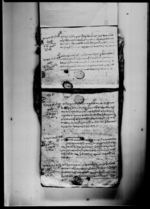A copy of a lālamohara from King Gīrvāṇayuddha appointing Vaijanātha Arjyāla and Vetu Arjyāla as priests at Gorkhā's Upallokoṭ (VS 1873)
ID: K_0013_0020E
Edited and
translated by Astrid Zotter
Created: 2018-06-07;
Last modified: 2023-02-17
For the metadata of the document, click here
The accompanying edition, translation/synopsis and/or commentary are available under the terms of the Creative Commons Attribution-ShareAlike 4.0 International License
Abstract
This copy of a lālamohara from the king, who according to the date must have been Gīrvāṇayuddha, appoints Vaijanātha Aryāla and Vetu Arjyāla to the office of priest for the Dasaĩ rituals at Gorkhā's Upallokoṭ, replacing Rāmacandra Arjyāla.Diplomatic edition
[1r]
1पो१३पा५३सी३२३2६२नं
3
4भंनौहर्ष
5
2षाय़लगोर्षाऊपल्लाकोट्कोपुरोहीटाईतस्कोजागीरषेतमु
3री•७०लगापात•समेतवक्स्यौंपरापुर्वकारीतसंगदसैंचला
4ईगुठीजानीभोग्यगरईतीसम्वत्१८७३सालभाद्रवदी५रोज
5३शु¯¯¯¯¯¯¯¯¯¯¯¯¯¯¯¯¯¯¯¯¯¯¯¯¯¯¯ [Unknown seal] [Unknown seal]
Translation
[1r]
[In the left margin:]
Bundle (po[kā]) 13, pā 53, sī 3231
Number 622
The one who said: Nau[sindā]Harṣa4
[Main text:]
Āge: To Vaijanātha Arjyāla [and] Vetu Arjyāla5
We [hereby] confer [upon you] Rāmacandra Arjyāla's holdings (khāyala): the office of priest (purohiṭāī for purohityāī̃) at Gorkhā's Upallokoṭ (text: Ūpallākoṭ) [and] an emolument (jāgira) [of] 70 muris of irrigated land (kheta) together with the surrounding land (lagāpāta). Perform the Dasaĩ [rituals] according to what has been traditionally established and, considering the guṭhī [as yours] enjoy it.
Tuesday, the 5th of the dark fortnight of the month of Bhādra, in the [Vikrama] era year 1873 (1816 CE).6 Auspiciousness.7
[Unknown seal]
[Unknown seal]
Commentary
This document formally fills the vacant office of the priest responsible for conducting the Dasaĩ rituals at Gorkhā's Upallokoṭ. This post at the "upper fort" on a hilltop above the royal palace seems to have been one reassigned fairly regularly to new persons, or else rotated among a fixed group. Thus one Vaijanātha Josī, probably the same person who is called Vaijanātha Arjyāla in the present document, had been appointed in VS 1862 (1805 CE); see K_0029_0044A for the appointment document issued to him, and K_0029_0044B for one issued to officials ordered to provide him with necessary materials. For an enumeration of the different post-holders mentioned in other follow-up documents, see the edition of K_0029_0044A.

